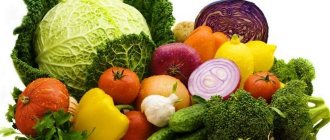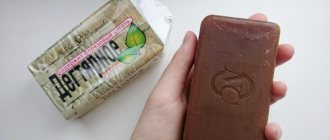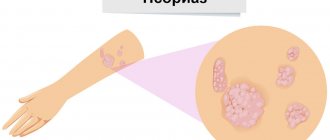Scientists have found that psoriasis very often recurs when acid reactions in the patient’s body predominate over alkaline ones. That is why, in order to maintain stable remission, a patient with this complex disease must strictly follow the diet prescribed to him.
The diet is based on an accurate calculation of the daily diet, taking into account the main rule: 65% or 75% of alkali-forming foods should be 35% or 25% acid-forming, respectively. The first type of products includes vegetables and fruits, and the second includes food products that contain fats, oils or starch proteins: potatoes, cheeses, cream, grain products and meat products.
The most important thing you have to watch out for when maintaining proper nutrition for psoriasis is drinking a sufficiently large amount of water per day, from seven to ten glasses. The liquids consumed should be of high purity, and in the case of consuming juices, it is recommended to prepare freshly squeezed ones.
IMPORTANT! When the skin is damaged by psoriasis, the patient needs not only to return to a diet from time to time, but to completely change eating behavior, since various errors in nutrition lead to the accumulation of toxins and disruption of the body’s metabolic processes, which, in turn, leads to a new exacerbation of the disease.
Due to the diet, the patient’s body corrects:
- amount of toxins;
- constancy of acid-base balance;
- stability of metabolic processes;
- proper functioning of the immune system;
- work of the gastrointestinal tract.
Basic principles of proper nutrition for psoriasis
- Following a diet in which the body receives food in small portions with three-hour breaks between them. Such food consumption reduces the load on the patient’s digestive system.
- With psoriasis, there are restrictions on the methods of culinary processing of the food consumed by the patient. For example, fried and baked foods should be completely excluded from the diet, leaving only cooking, stewing and steaming of foods in order to facilitate the work of the pancreas and liver.
- Restrictions also apply to alcoholic beverages, since the consumption of any alcohol poisons the patient’s body with decay products, causing intoxication and disrupting the proper functioning of all organs of the digestive system. Drinking alcohol leads to an exacerbation of the disease and is strictly contraindicated.
- In case of psoriasis, attention should be paid to the patient’s consumption of fiber, as it ensures the movement of digested food and stabilizes the contractile function of the intestine, facilitating the timely removal of toxins and waste from the human body. Also, fiber is a good source of vitamins, macronutrients and microelements.
- A patient with psoriasis will need to carefully monitor their body weight, since the presence of excess weight provokes the development of diseases that lead to relapses and complicate the course of psoriasis: obesity, metabolic syndrome, diabetes mellitus.
Methods with a sedative effect on the body
Sedative effect - calming, relieving stress (without hypnotic effect).
- Oregano infusion. Take 2 tsp.
herbs, pour boiling water over it, let it brew. Take warm 3-4 times a day, half a glass, before meals. Oregano - Tincture of motherwort herb (proportion 1.5:20). Take 30-50 drops 3-4 times a day.
- Infusion of valerian officinalis (rhizome with roots). Take 6-20 g of the plant, pour a glass of boiling water.
Take 1 tbsp. l. 3-4 times a day. Valerian officinalis - Decoction of common chicory. Pour a glass of boiling water over a teaspoon of crushed root. Take a quarter glass 4 times a day.
- Tincture of evasive peony. Take 30-40 drops to a teaspoon 3 times a day, before meals. Course - 30 days.
- Blue cyanosis infusion. Proportion - 0.6-0.8:20. Take 1 tbsp. l. 3-5 times a day.
- Infusion of fireweed angustifolia. Take 2 tbsp. l. herbs, pour 2 cups of boiling water and leave for 6 hours. Take this dose 1 time per day.
- Spring primrose decoction. The proportion of roots is 2:40. Take half a glass 3-4 times a day. The proportion of leaves is 1.5:20. Take half a glass 3 times a day.
What can you eat if you have psoriasis?
Foods you can eat if you have psoriasis:
- Fruits, except strawberries and wild strawberries. When ingested, fruits most often give an alkaline reaction. Fruits that are considered acid-forming should be consumed in minimal quantities - there are only five of them: prunes, blueberries, plums, cranberries and currants. If a patient has psoriatic arthritis, citrus fruits and their juices should be excluded from the diet.
- Vegetables. For psoriasis, almost all vegetables are allowed. Acid-forming fruits should be treated with caution. These are legumes (peas, chickpeas, lentils and beans), corn, pumpkin, avocado, Brussels sprouts and rhubarb.
- Cereals, such as rye, oatmeal and corn, bran and baked goods made with them.
- Fish.
- Nuts, sesame and sunflower seeds.
- Olive oil.
- Alkaline mineral water.
Foods that can be eaten in limited quantities if you have psoriasis:
- Mushrooms.
- Fermented milk products and cheeses (preferably low-fat).
- Lean meat of chickens, rabbits, sheep and turkey (allowed to be consumed no more than a couple of times a week).
- Garlic, celery, zucchini, onions and beets.
- Olives.
- Bananas, melons and apples should be eaten only in their pure form, not mixed with other foods).
- Potato dishes.
- Eggs (no more than 1 per week).
Healthy foods
For psoriasis, any fermented milk products are useful, but only low fat. Nutritionists recommend that patients more often consume soft cheeses without spices, Varenets, fermented baked milk, yogurt, and kefir. Children's diets should include cottage cheese and drinking yogurt without dyes or flavors. The following products should also be included in the weekly menu:
- boiled eggs or omelettes;
- lean meats - turkey, rabbit, chicken breast, lamb;
- fatty fish - salmon, Norwegian herring, sardines;
- dried whole grain bread;
- cereal porridges - buckwheat, millet, wheat, corn;
- salads from white cabbage, beets, parsley, seasoned with any vegetable oil;
- zucchini, greens and celery root vegetables, carrots.
Products must not be deep-fried or fried. They should be simmered in a small amount of water or baked. Steamed vegetables, meat or fish retain the maximum possible amount of nutrients, macro- and microelements, fat- and water-soluble vitamins.
Nutritionists recommend eating fruits and dried fruits as desserts. The daily consumption of figs, dried apricots, pineapple, grapes, cherries, peaches, and dates is especially beneficial. Of the citrus fruits, only grapefruit is allowed. The thick peel of the fruit must be cut off. Don't forget about nuts (walnuts, cashews, pistachios, hazelnuts), pumpkin and sunflower seeds. They perfectly alkalize the body, minimizing the risk of relapse of psoriasis.
What is forbidden to eat if you have psoriasis?
- Fatty meats such as duck, pork and canned meats.
- Stewed meat and fatty pates.
- Rich broths.
- Smoked meats.
- Any sausage products.
- Fatty sauces (for example, mayonnaise).
- Fast food.
- Dairy products with a high fat content, for example, thirty percent cheese, ten percent sour cream, butter.
- Cream.
- Sweet curd mass.
- Red and black caviar.
- Canned fish.
- Bean products.
- Salo.
If you have psoriasis, you need to exclude not only alcohol from your daily diet, but also completely avoid soda and coffee, as this drink can cause metabolic disorders. As an alternative, chicory roots can be used.
Freshly squeezed juices should not be consumed in their pure form, but should be diluted with water in a ratio of 1:2, as they contain a high concentration of essential oils.
What should you not eat?
Prohibited foods for psoriasis and those that should be significantly limited during a therapeutic diet include:
- bread and any baked goods;
- fatty meats and fish, fried eggs;
- fried foods, smoked meats, canned food;
- nuts and oils based on them;
- spices and herbs;
- citrus fruit;
- alcohol;
- sweets and carbonated drinks;
- sausage;
- margarine and store-bought sauces.
Important! If, while following a diet for psoriasis, you abandon this list of products, you can achieve long-term remission of the disease.
Example of a weekly menu for psoriasis
An important feature of the menu below is that, whenever possible, it excludes products that are partially restricted for consumption by patients with psoriasis, which makes it almost protein-free.
Monday
1 meal: one apple, wheat porridge with pumpkin and herbal tea.
Meal 2: borscht in water (350 ml) with two slices of bread, a glass of dried fruit compote and 100 grams of dietary boiled meat.
Meal 3: vegetable salad in olive oil, 100 grams of stewed mushrooms and one glass of fruit juice.
Meal 4: two bananas or a glass of low-fat yogurt.
Tuesday
1 meal: 250 grams of oatmeal in water with the addition of pine nuts, a glass of juice and one banana.
Meal 2: vegetable soup with rice, 200 grams of steamed salmon, a glass of green tea.
Meal 3: 100 grams of dietary fish, chamomile tea, Chinese cabbage, cucumbers and herbs.
Meal 4: a glass of kefir and two apples.
Wednesday
1 meal: 300 ml of vegetable puree soup and a glass of juice.
Meal 2: sliced vegetables, 250 grams of steamed trout, 50 grams of dietary cheese and black tea.
Meal 3: two tomatoes, a glass of rosehip broth, pearl barley porridge.
Meal 4: one banana or a glass of diet yogurt.
Thursday
Meal 1: rice vegetable porridge, three pieces of dried apricots and a cup of herbal tea.
Meal 2: 350 ml of beetroot, 200 grams of boiled turkey and a glass of juice.
Meal 3: vegetable salad and 200 grams of boiled fish, a glass of linden tea.
Meal 4: a glass of fruit jelly or 2 pears.
Friday
Meal 1: two boiled eggs, vegetable salad and a glass of juice.
Meal 2: buckwheat porridge, 200 grams of fish baked in a sleeve with vegetables and a glass of green tea.
Meal 3: 300 grams of green borscht, 100 grams of stewed mushrooms, two slices of bread and herbal tea.
Meal 4: a glass of juice or two bananas.
Saturday
Meal 1: oatmeal with raisins and a glass of black tea.
Meal 2: vegetable puree, two steamed fish cutlets and green tea.
Meal 3: 300 grams of vegetable soup, 150 grams of boiled fish, two pieces of bread and dried fruit compote.
Meal 4: one apple or a glass of rosehip decoction.
Sunday
1 meal: 200 grams of steamed omelette, two slices of bread and a glass of compote.
Meal 2: vegetable soup with cereal, 200 grams of boiled salmon and a glass of herbal tea.
Meal 3: 350 grams of lard, two slices of bread, 150 grams of boiled fish and a glass of rose hip broth.
Meal 4: two bananas or a glass of fruit jelly.
We hope you will be able to achieve stable remission, including through proper nutrition for psoriasis. And if plaques begin to bother you greatly, pay attention to Rederm ointment. This complex action product is based on a combination of two components, betamethasone and salicylic acid. The ointment softens and exfoliates rough skin, relieves inflammation and redness, eliminates itching and reduces allergic manifestations.
Recipes for psoriasis patients
The diet for psoriasis includes a fairly large list of products and dishes that can be used in the daily menu. If patients with psoriasis think that while on a diet it is impossible to set a delicious table for guests, they are mistaken. Below are detailed recipes for two dishes that you can prepare not only for yourself, but also put on the table for the holidays.
Salmon with vegetables
Salmon with vegetables is a dish that is perfect for those who follow a diet for psoriasis.
Ingredients
- zucchini – 1 pc.;
- broccoli – 100 g;
- mushrooms – 5-7 pcs.;
- cauliflower – 100 g;
- salmon steaks – 0.5 kg.
Cooking method
- It is necessary to rinse and peel the mushrooms and zucchini, and thoroughly wash the broccoli and cauliflower.
- Cut all vegetables into small cubes and steam until half cooked.
- Next, take the foil, form it into boats with a margin around the edges, and put 100-120 g of vegetables in each.
- Place pre-prepared salmon steaks on top. Wrap in foil so that the sides of the fish are protected and the top is exposed.
- Sprinkle salmon with lemon juice and garnish with chopped dill. Place in the oven.
- After 20 minutes, the dish can be served, additionally garnished with lemon rings and herbs.
Rabbit cutlets
Rabbit cutlets are also suitable for those on a diet.
Ingredients
- rabbit fillet – 0.3 kg;
- carrots – 1 pc.;
- chicken egg – 1 pc.;
- bell pepper – 1 piece;
- greenery;
- salt.
Cooking method
- Grind the fillet, add the egg, add salt, and mix thoroughly.
- Separately, cut the pepper into small cubes, grate the carrots, and chop the herbs.
- Form balls from the minced meat, stuff them with pepper, roll in grated carrots and herbs.
- The cooking process is carried out in a slow cooker or double boiler.
The diet of patients with psoriasis who are on a diet should be varied and fortified. This will not only keep the disease in remission for a long time, but also replenish the reserves of nutrients in the body.
Can seborrheic dermatitis be cured with nutrition?
Of course no. A proper, nutritious diet is an aid. The main solution for the treatment of seborrheic dermatitis in adults, both on the head and on the face, is properly selected care products or, in especially difficult cases, medications prescribed by a doctor. At home, you should use products from the Sulsen series to care for the scalp with seborrheic manifestations: shampoo, paste, peeling, cream, oil. They contain selenium disulfide and quickly suppress the activity of the yeast-like fungus that causes seborrhea, and also bring balance to the scalp.
conclusions
Psoriasis is a disease that affects several body systems. Many people wonder whether is contagious or not . We answer: no, the disease is not contagious. Its causes are mainly genetic.
Traditional medicine suggests treating psoriasis internally and externally. Sanatoriums where psoriasis is treated also use traditional methods. Mud, mineral baths, and water treatments help cure the disease.
Despite its safety, this method of treating psoriasis is too complicated and long . Just think that out of 53 recipes you will have to choose a few. Then find these medicinal plants, prepare them, prepare your own decoctions, tinctures, ointments. And don’t forget to take several of these homemade medicines a day. This will take 1-2 hours a day (minimum).
In addition, the minimum course of treatment is a month. But this is with a mild course of the disease and in the initial stage. And no doctor can guarantee that you will be cured in this month. Simply because psoriasis is individual for everyone and the disease is poorly understood. In short, modern medicine offers more convenient and effective methods of treating psoriasis.
Medicinal products to improve body tone
In complex treatment, it is important to reduce body fatigue and increase overall tone. Folk remedies for psoriasis help to do this
- Infusion of St. John's wort. The proportion is 1:20. Take a third of a glass 3 times a day, half an hour before meals.
- Infusion (decoction) of white willow. Take 1 tbsp. l. bark, pour 2 cups boiling water. Take 2 tbsp. l. 3-5 times a day.
- Verbena infusion. Take 1 tbsp.
l. herbs, pour a glass of boiling water. Take 1 time per day. Verbena officinalis











